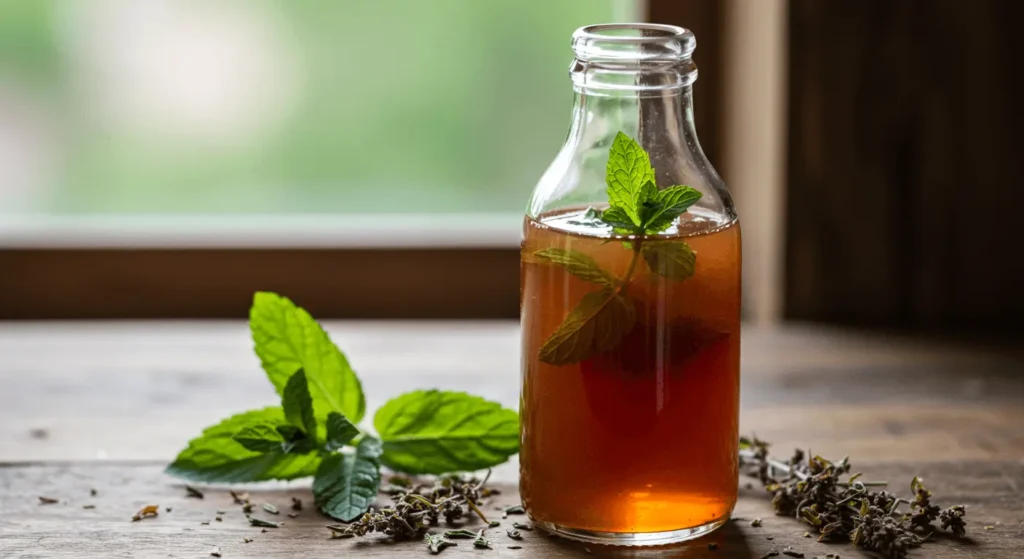Introduction
Herbal cordials are delightful and flavorful drinks made from a combination of herbs, sweeteners, and water. Known for their refreshing and medicinal qualities, herbal cordials have been enjoyed for centuries. By making your own herbal cordial at home, you have full control over the ingredients and can craft unique, personalized flavors. In this step-by-step guide, you’ll learn how to make the perfect herbal cordial. Whether you’re drawn to a calming chamomile blend or a refreshing lemon balm recipe, creating your own herbal cordial is both easy and rewarding. Let’s dive into the simple process of making this natural, flavorful herbal cordial that you can enjoy anytime.
What is Herbal Cordial and Why Make It at Home?
Definition of Herbal Cordial
Herbal cordial is a sweet, concentrated syrup made by infusing herbs with water and sweeteners. The herbs impart their unique flavors, creating a rich, aromatic base. The sweeteners balance the bitterness of the herbs, making the drink more pleasant. Herbal cordials are typically made with fresh or dried herbs like mint, chamomile, or elderflower. These infusions are then sweetened to taste with ingredients like sugar or honey. The resulting syrup can be diluted with water or added to other beverages for a refreshing, flavorful drink.
Benefits of Making Your Own Herbal Cordial
Making your own herbal cordial gives you complete control over the ingredients. You can choose your favorite herbs, sweeteners, and flavor combinations. Homemade cordials are free from artificial additives or preservatives, making them a healthier option. You can adjust the sweetness and strength of the cordial to suit your taste. It also allows you to experiment with different herbal blends, creating unique flavors. Homemade cordials are cost-effective compared to store-bought versions and offer a more personal touch.
Uses of Herbal Cordials
Herbal cordials are versatile and can be used in many ways. They make refreshing, relaxing drinks when diluted with water or soda. Cordials can also serve medicinal purposes, as many herbs have soothing or healing properties. Additionally, herbal cordials can be mixed with other beverages, like teas or juices, for added flavor. They are also a great way to enhance homemade smoothies or desserts. Herbal cordials offer endless possibilities for both relaxation and enjoyment.
Essential Ingredients for a Perfect Herbal Cordial
Common Herbs Used in Herbal Cordials
Mint is a popular herb used for its refreshing, cooling flavor. It pairs well with many herbs and fruits. Lavender adds a calming, floral note that’s perfect for relaxing. Chamomile, known for its soothing properties, creates a gentle, sweet flavor. Elderflower offers a delicate, fragrant taste that complements citrus and other herbs. Lemon balm brings a light, citrusy flavor that’s refreshing and energizing. Other herbs like rosemary, thyme, and basil can also add complexity to your cordial. Mixing these herbs allows you to create unique blends with varying flavors and benefits.
Choosing the Right Sweeteners
Sweeteners are crucial for balancing the herbal flavors in your cordial. Honey provides a rich, natural sweetness that pairs well with floral herbs. Sugar, whether white or brown, is a classic choice, offering a neutral sweetness. Stevia, a calorie-free option, is perfect for those looking to reduce sugar intake. Adjusting the amount of sweetener lets you control the level of sweetness. You can experiment with different sweeteners or combinations to match the flavor intensity of the herbs used. The goal is to create a harmonious balance between the herbs and sweetness.
Making a Non-Alcoholic Cordial
When making herbal cordials, the base liquid can be water or herbal tea. The infusion process extracts the flavors of the herbs into the liquid. Sweeteners are then added to enhance the taste, with optional citrus or spices for added complexity. Non-alcoholic cordials are refreshing and can be enjoyed by everyone, providing a flavorful, naturally sweet beverage. The absence of alcohol allows the herbal flavors to shine, creating a pure, vibrant drink that’s easy to customize. Non-alcoholic cordials are versatile, perfect for all occasions.
Step-by-Step Guide to Making the Perfect Herbal Cordial
Preparing the Herbs for Infusion
Start by choosing your herbs, whether fresh or dried. Fresh herbs should be rinsed gently to remove any dirt. Measure out the herbs according to the recipe or personal preference. Typically, use about 1 to 2 tablespoons of dried herbs or a handful of fresh herbs per cup of water. Chop larger herbs into smaller pieces to release more flavor. For stronger infusions, use a bit more of the herbs, adjusting based on your desired strength. Fresh herbs should be bruised slightly to release oils, while dried herbs are usually added directly. Properly preparing the herbs ensures you extract the maximum flavor.
Infusion Process and Timing
To infuse the herbs, bring water to a gentle simmer, then pour it over the herbs in a heatproof container. Cover the mixture to trap steam and preserve volatile compounds. Let the herbs steep for about 15 to 30 minutes, depending on the strength desired. The longer you steep, the stronger the flavor will be. Be mindful not to over-steep, as it may result in bitterness. After the infusion is complete, strain out the herbs, ensuring you only keep the liquid. The infusion process extracts the flavors, allowing the herbs to release their essential oils and properties.
Sweetening and Straining the Cordial
Once the infusion is ready, add sweetener to your taste, such as honey, sugar, or stevia. Stir the mixture well while it’s still warm until the sweetener dissolves completely. You can adjust the amount of sweetener based on your preference for sweetness. After sweetening, strain the infusion again to remove any remaining herb particles. Use a fine mesh sieve or cheesecloth for a clear, smooth liquid. Straining ensures that the final cordial has a clean, pleasant texture without bits of herbs. At this point, the cordial is ready for storage or serving.
Bottling and Storing Your Herbal Cordial
After straining, let the cordial cool to room temperature before transferring it into sterilized glass bottles or jars. Choose containers with tight-fitting lids to prevent air from entering and spoiling the mixture. Ensure the bottles are sealed tightly and stored in a cool, dark place. The cordial can be kept for several weeks in the refrigerator. Always label your bottles with the date and ingredients for easy tracking. If stored properly, herbal cordials maintain their flavor and freshness for a long time, making them a delightful and lasting homemade treat.
Flavor Variations and Herbal Blends to Try
Refreshing Mint and Lemon Balm Cordial
For a refreshing mint and lemon balm cordial, steep fresh mint leaves and lemon balm in hot water. Let the herbs infuse for 15 minutes, then strain. Add a sweetener like honey or sugar to taste, and stir until dissolved. For extra flavor, squeeze in some fresh lemon juice. This cordial is perfect for a refreshing, cooling drink on warm days. Serve it diluted with cold water or sparkling water for a fizzy, bright treat. The mint adds a cooling, crisp flavor, while lemon balm brings a hint of citrusy sweetness. It’s a simple yet flavorful blend that’s perfect for hydrating and refreshing your body.
Chamomile and Honey Cordial for Relaxation
To make a calming chamomile and honey cordial, steep dried chamomile flowers in hot water for 10 minutes. Strain the liquid, then stir in honey until dissolved. Chamomile has soothing properties that help reduce stress, while honey adds natural sweetness. This cordial is ideal for unwinding after a busy day. You can enjoy it warm to enhance the calming effects or chilled for a refreshing, relaxing drink. Chamomile and honey together create a peaceful, comforting blend, perfect for helping you relax and unwind.
Elderflower and Citrus Cordial
For a fragrant elderflower and citrus cordial, steep fresh elderflowers with lemon zest and orange peel in hot water. Let it infuse for about 20 minutes, then strain the mixture. Add sugar to taste and stir until dissolved. This cordial has a sweet, floral flavor with a citrusy tang. Elderflower’s delicate taste pairs perfectly with the bright and refreshing citrus notes. Serve chilled over ice for a delightful, light drink. It’s an elegant, aromatic blend that can be enjoyed on a warm afternoon or at any gathering.
Experimenting with Spices and Herbs
Experimenting with spices and herbs allows you to create unique, flavorful cordials. Add a cinnamon stick to a mint infusion for warmth and spice. Ginger root can be added to create a zesty, refreshing kick. Try incorporating rosemary for an earthy, herbal note that complements citrus blends. You can mix these spices with herbs like lavender or thyme to create more complex flavors. Play around with combinations, adjusting sweetness and intensity to suit your taste. The beauty of homemade herbal cordials lies in your creativity, so don’t be afraid to experiment with different herbs and spices.

Serving and Enjoying Your Herbal Cordial
How to Drink Herbal Cordial
Herbal cordial is versatile and can be enjoyed in several ways. The most common method is to dilute it with water. Adjust the ratio of cordial to water based on your preferred sweetness and strength. For a fizzy option, mix the cordial with sparkling water or soda. This creates a refreshing, effervescent drink perfect for a hot day. You can also enjoy herbal cordial over ice for a cool, relaxing beverage. If you prefer a warm drink, simply mix the cordial with hot water for a soothing option. The unique herbal flavors become even more aromatic when heated, making it perfect for chilly evenings.
Pairing Herbal Cordials with Foods
Herbal cordials pair wonderfully with light, fresh foods. A classic match is herbal cordial with mild cheeses, such as goat cheese or brie. The freshness of the cordial complements the creamy richness of the cheese. Herbal cordials also go well with fruit-based desserts, like lemon tarts or fruit sorbets. The bright, zesty flavors of the cordial enhance the sweetness of fruit dishes. Light salads with fresh herbs and grilled vegetables are also ideal companions, as the cordial enhances the natural flavors of the food.

Creative Cocktail Recipes Using Herbal Cordial
Herbal cordials can be a great addition to creative, non-alcoholic cocktails. Try mixing it with sparkling water and a splash of citrus for a refreshing mocktail. Another idea is combining herbal cordial with iced tea for a unique twist. You can even add a spoonful of herbal cordial to smoothies for an added burst of flavor. For a more festive option, mix the cordial with ginger ale and fresh fruit garnishes, creating a delightful, sparkling drink. The versatility of herbal cordials allows for endless creativity in crafting refreshing beverages.
Conclusion
Making your own herbal cordial at home is both rewarding and enjoyable. It allows you to create refreshing, flavorful drinks tailored to your taste. Using fresh herbs and natural sweeteners ensures a healthier alternative to store-bought options. Herbal cordials offer a delicious way to enjoy the benefits of plants and herbs. With simple steps and a variety of herbs, you can craft unique blends for any occasion. Whether served chilled or warm, herbal cordial is a versatile beverage. Experimenting with flavors encourages creativity and personal expression in your kitchen. Embrace the tradition of herbal cordials to bring natural goodness into your daily routine. Start your herbal cordial journey today and enjoy this refreshing, homemade delight!




